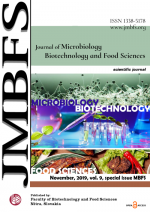INHIBITORY EFFECT OF ESSENTIAL OILS ON THE GROWTH OF GEOTRICHUM CANDIDUM
DOI:
https://doi.org/10.15414/jmbfs.2019.9.special.380-384Keywords:
essential oils, inhibitory effect, Geotrichum candidumAbstract
The aim of this study was focused on the determination of the inhibitory effect of selected essential oils on the growth of five isolates of Geotrichum candidum. The isolates were obtained from the dairy products of domestic origin (sour cream, raw cow's milk, base for production of the brand, unsalted cheese, and cheese made from cows' milk). We studied the impact of five essential oils [pure essential oil EOs (100 %)] - clove, basil, rosemary, fennel and thyme at concentration of 0.625 μL.cm-3 of air. Gas chromatography-mass spectrometry (GC-MS) analysis was used for the identification of the main components of EOs. We tested the effect of the essential oils by the gaseous diffusion method. The isolates were cultivated on PDA (Potato dextrose agar), in the dark, at 25 ±1 °C, 14 days. The diameter growing of colonies we continuously measured on the 3rd, 7th, 11th, and 14th day of cultivation. The results of the paper suggest that clove and thyme essential oil had 100 % inhibitory effect on the growth of all tested isolates. Fennel, basil and rosemary essential oil had not significant inhibitory effects on tested isolates Geotrichum candidum. However, these oils affected the growth of colonies throughout the cultivation. Fennel EO had 100 % inhibition only on the growth of one isolates of Geotrichum candidum to the 3rd day of cultivation. Basil EO had the stimultating effect on the growth of two isolates of G. candidum (KMi 322 and KMi 189). Our results showed that clove and thyme essential oil could be used as a natural preservative useful in the food industry.Downloads
Download data is not yet available.
Downloads
Published
2019-11-08
How to Cite
Foltinová, D., TanÄinová, D., & CÃsarová, M. (2019). INHIBITORY EFFECT OF ESSENTIAL OILS ON THE GROWTH OF GEOTRICHUM CANDIDUM. Journal of Microbiology, Biotechnology and Food Sciences, 9(Special issue), 380–384. https://doi.org/10.15414/jmbfs.2019.9.special.380-384
Issue
Section
Microbiology
License
Copyright (c) 2022 Denisa Foltinová, Dana TanÄinová, Miroslava CÃsarová

This work is licensed under a Creative Commons Attribution 4.0 International License.
All papers published in the Journal of Microbiology, Biotechnology and Food Sciences are published under a CC-BY licence (CC-BY 4.0). Published materials can be shared (copy and redistribute the material in any medium or format) and adapted (remix, transform, and build upon the material for any purpose, even commercially) with specifying the author(s).





